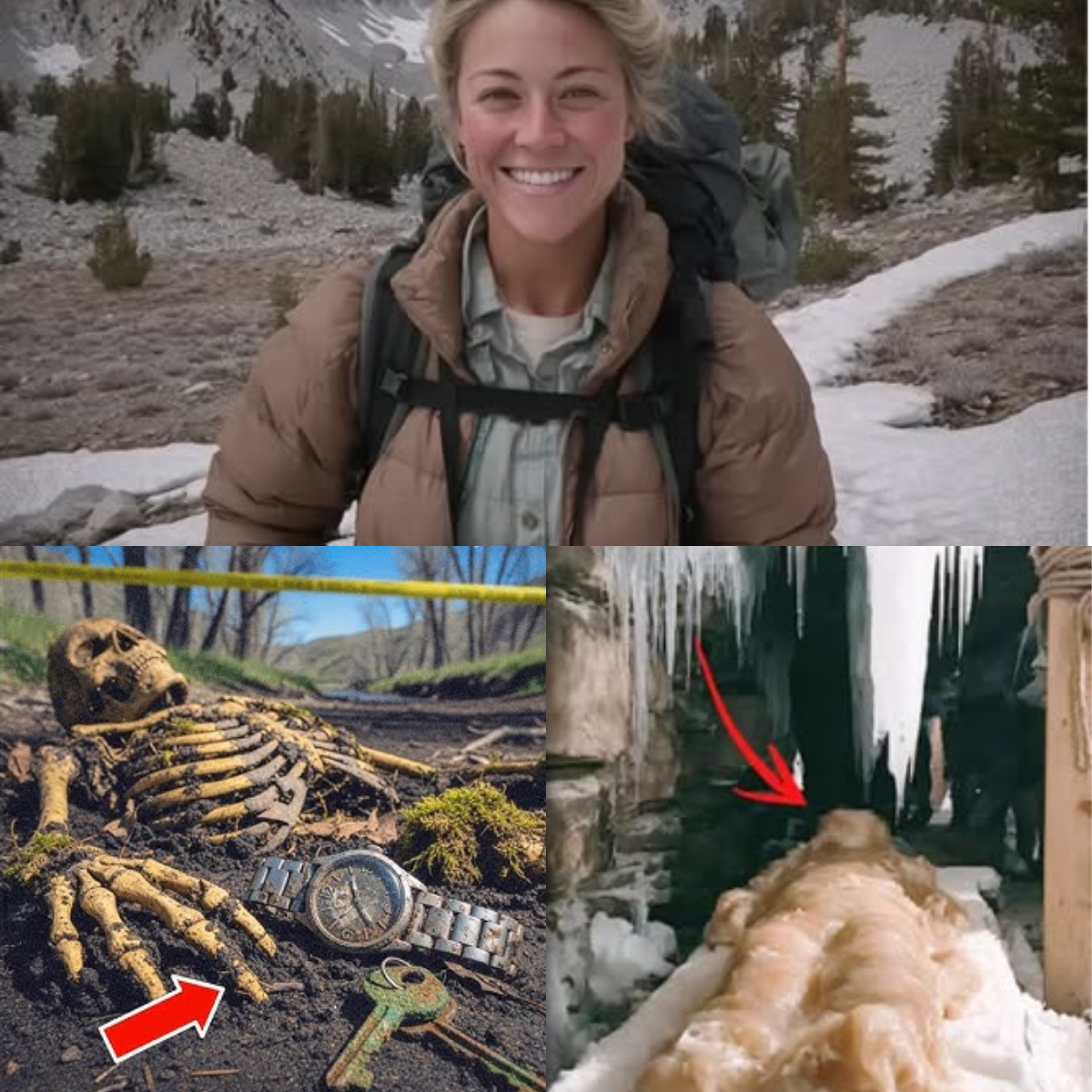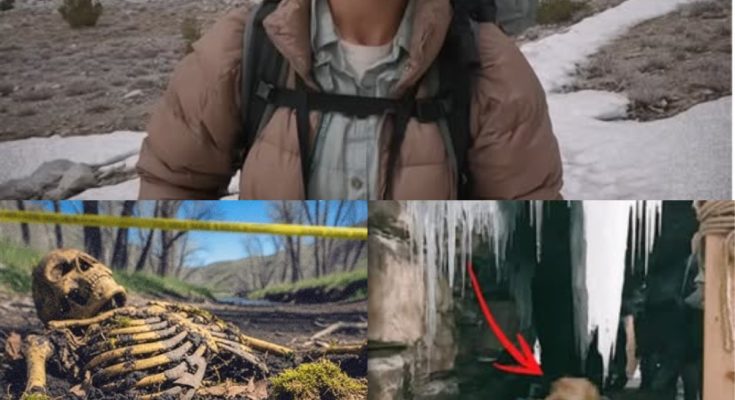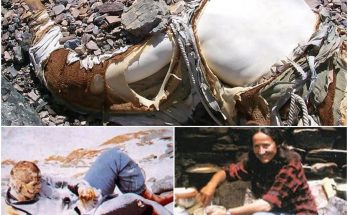🏔️ “THE BUZZING CAVE” — THE MYSTERY OF EMILY CARTER THAT DEFIES SCIENCE
Ten years after her disappearance in the Montana wilderness, what rescuers found beneath the ice has shaken the world of science, faith, and folklore alike.
THE GIRL WHO LOVED THE MOUNTAINS
In the summer of 2014, Emily Carter, a 28-year-old field biologist from Bozeman, Montana, set out on what she called her “solitude study” — a solo expedition into the Beartooth Range, one of the most remote and unforgiving mountain regions in the northern United States.
She wasn’t reckless. She’d done dozens of treks before — mapping alpine flora, tracking lynx populations, and studying the effects of climate change on high-altitude pollinators. Her colleagues described her as fearless but meticulous, the kind of person who logged every observation, every sample, every sunrise.
Her final message, sent to her mother via satellite phone on August 9, 2014, was simple:

“Reached the glacier. It’s beautiful up here. You’d love it. Back by Sunday.”
That was the last anyone ever heard from her.
When she didn’t return, the search began immediately — helicopters, drones, volunteer mountaineers, park rangers, dogs. For twelve days, they combed through ravines and crevasses. All they found was her backpack, lying beside a frozen stream. Inside: her field notebook, a half-finished jar of honey, and a small, hand-carved wooden bee.
Everything else — her tent, her food, her equipment, even her boots — was gone.
A DECADE OF SILENCE
Emily’s disappearance became one of Montana’s most haunting cold cases.
There were no signs of struggle, no wild-animal traces, no evidence of a fall.
Her family refused to give up. Every year, on the anniversary of her disappearance, they held a small vigil near the trailhead — candles flickering against the endless snow. Her mother, Patricia Carter, always left a small jar of honey at the site.
“She loved bees,” Patricia once told reporters. “She said they were the soul of the mountains — tiny, tireless, and full of mystery.”
But the mystery only deepened as time passed.

In 2016, a hiker reported hearing a “low hum” emanating from a glacier cave not far from Emily’s last GPS ping. Investigators found nothing. In 2019, another search dog alerted near the same area — again, no trace. Locals began whispering about the humming ice, an eerie sound that came and went with the thaw.
Then, in March 2024, everything changed.
THE DISCOVERY UNDER THE ICE
A group of experienced hikers — two men and a woman from Colorado — were exploring a newly exposed ice cave after a rare warm spell. They followed a narrow passage that led deep into the glacier’s belly, their headlamps slicing through the darkness.
One of them, Aaron Willis, later described the moment that stopped them cold:
“We thought it was a statue at first. It looked too perfect. But then we saw the hair — real, frozen strands — and we knew.”
Lying on a stone altar-like slab, perfectly preserved, was the body of a woman.
Her skin had a faint golden sheen. Her eyes were closed, her expression serene — almost peaceful. But the surface of her body was entirely coated in a thick layer of beeswax, smooth and glistening even in the frigid air.
Around her, the cave walls were carved with spiral symbols and hexagonal patterns that eerily resembled a honeycomb. Meltwater dripped from the ceiling like slow tears.
Willis’s companion captured everything on video — footage that, according to sources, was immediately turned over to authorities.
The face was unmistakable.
It was Emily Carter.
THE IMPOSSIBLE PRESERVATION
When search-and-rescue teams arrived two days later, they were met with something even more unnerving: a constant, low buzzing sound that seemed to emanate from deep within the ice surrounding the chamber.
Specialists from Montana State University and the FBI’s forensic division confirmed the body’s identity through dental records. But the condition of the remains defied every law of biology.
There were no signs of decay.
Her skin, hair, and even eyelashes were intact.
The wax encasing her body contained organic compounds similar to beeswax, but with trace elements of alpine minerals and pollen that do not occur naturally together.
“This is unlike anything we’ve seen,” said Dr. Lena Voss, lead forensic pathologist. “It’s as if the wax was secreted or applied while she was still… warm. There’s no evidence of human interference. And yet, it’s deliberate.”
Even stranger, no bees — dead or alive — were found anywhere near the site.
And yet, that faint hum never ceased.
THE SYMBOLS ON THE WALLS
Archaeologists brought in to examine the carvings identified them as non-Native, non-modern — a mixture of Celtic, Slavic, and pre-Christian symbology. Among them was a recurring motif: a circle of six hexagons surrounding a central spiral.
Local historians later noted that similar patterns were once used in ancient “melissic” cults — secret societies in Europe devoted to bees and the goddess of rebirth.
According to fragmented myths, followers believed that bees carried the souls of the dead across realms, preserving them in “amber until the world was ready to awaken them.”
Was Emily’s death a coincidence — or something orchestrated by someone who still believed in those ancient rites?
THE MISSING MONTHS
The timeline made no sense.
Scientists determined that Emily’s body had not been frozen for ten years, as expected. Radiocarbon analysis of the wax revealed it was formed approximately three years ago — around 2021.
That meant, somehow, her body had been moved or re-treated years after she vanished.
But by whom? And why?
A park ranger who assisted in the recovery reported another chilling detail:
“When we tried to lift her, the ice underneath cracked — and that’s when we heard it again. The buzzing. It wasn’t coming from the walls. It was coming from beneath her.”
When the ice was finally cut open for extraction, investigators found a hollow chamber directly under the stone slab — filled with thousands of frozen bees, perfectly preserved, as if they’d died in formation.
THEORIES, FEAR, AND THE UNKNOWN
The scientific community has offered multiple hypotheses:
-
Natural preservation — the unique mix of minerals, cold, and waxy substances may have slowed decomposition.
-
Cult activity — ritualistic placement suggesting post-mortem staging.
-
Environmental anomaly — bees drawn to her decomposing remains could have created a wax encasement before freezing solid.
But none explain the freshness of the wax or the acoustic phenomenon — that persistent, almost rhythmic hum recorded by the rescue team.
“It wasn’t wind,” said one rescuer. “It was… alive.”
Social media exploded with speculation — from alien preservation experiments to secret government bio-tests. Paranormal enthusiasts dubbed the cave “The Hive Below.”
Locals in nearby Cooke City now refuse to approach the site after sunset. Hunters report hearing low humming near the glacier on still nights. Some even claim to have seen golden lights flickering beneath the ice.
THE NOTE IN HER JOURNAL
Among Emily’s recovered belongings, one page of her field notebook stood out. The ink was faded, but legible:
“There’s a hum beneath the ice — steady, alive. The bees shouldn’t be here this high up. But they are. They follow the warmth that shouldn’t exist.”
That was the last line she ever wrote.
THE FINAL BUZZ
As of this month, the cave remains sealed off under federal protection. Officially, the cause of Emily Carter’s death is listed as “undetermined environmental factors.”
Unofficially, everyone who’s seen her body agrees on one thing: it looks less like she died — and more like she was preserved for a purpose we still don’t understand.
Her mother, now 64, keeps the final photo Emily sent — smiling against a backdrop of endless snow — framed beside a jar of honey that has never crystallized, even after a decade.
“They say time froze her,” Patricia said quietly during a recent interview. “But I think time just waited — for her story to be told.”
And as for the cave?
Those who’ve been inside say that even now, if you stand still long enough, you can still hear it — that low, trembling buzz, echoing beneath the ice.
Not the wind.
Not the mountain.
Something else.
Something that should have stayed asleep.



